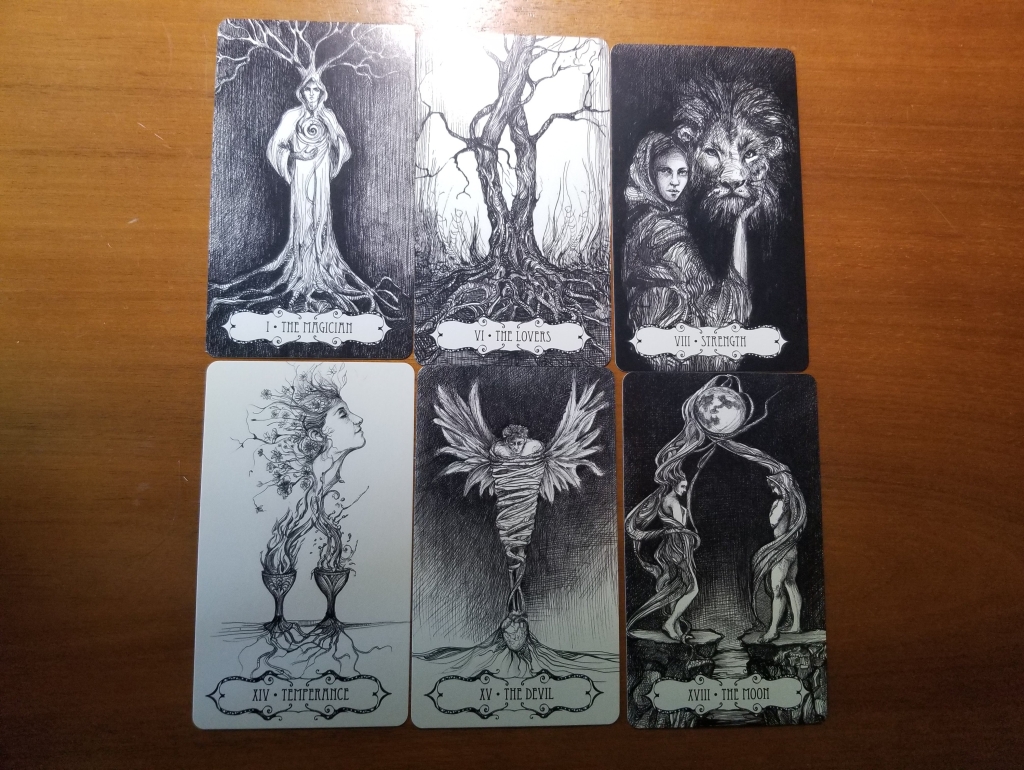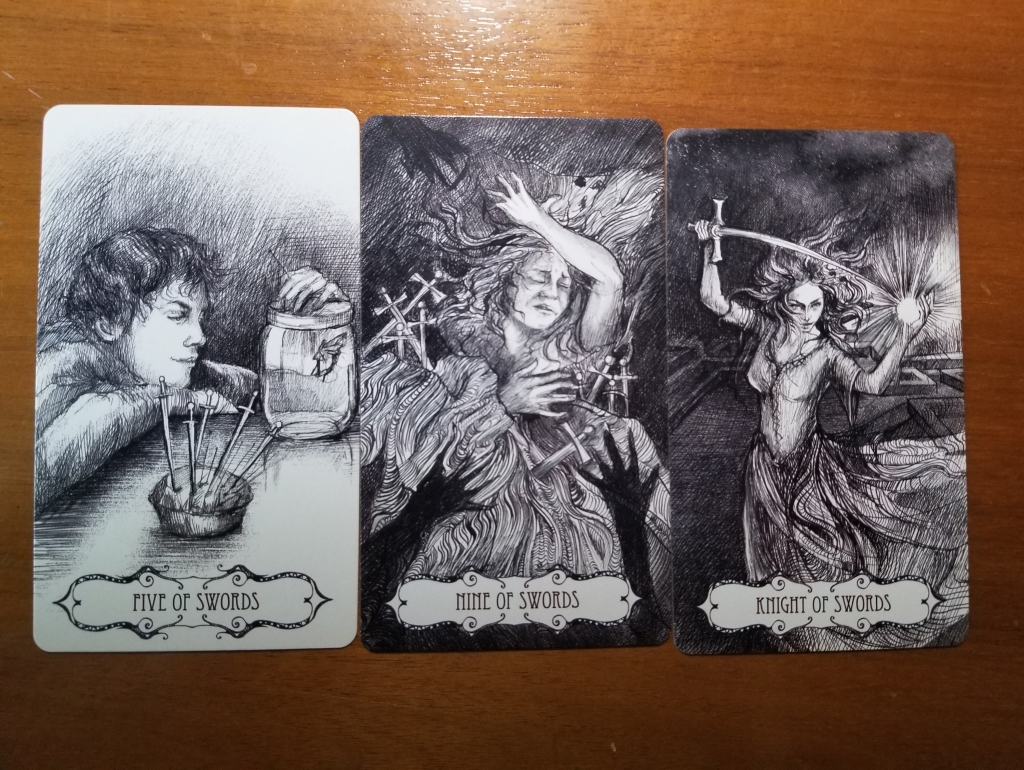The Tarot of the Abyss is a new deck from artist Ana Tourian, published by US Games. I’ve been following the creation of this deck basically since Tourian started illustrating it, and holy shit, this deck is gorgeous. I am absolutely, unequivocally, unreservedly head-over-heels in love with this deck.
For those who don’t recognize the name, Ana Tourian is the illustrator of the Hidden Waters Tarot, which I’ve reviewed on this blog, as well as the Bonestone & Earthflesh Tarot and the Oracle of Echoes. She also has yet another Tarot deck, the Tarot of Echoes, in progress. The Tarot of the Abyss, her latest release, is a sketchbook-style black-and-white deck rooted largely in RWS imagery, but with insightful twists on many of the classic cards. I’ve had the privilege of meeting Ana in person, and she is a charming individual in addition to being such a talented artist.
I’ve always been a sucker for black-and-white decks, so it should come as no surprise that I love the Tarot of the Abyss as much as I do. The choice to render everything in black ink gives Tourian the opportunity to play with light and shadow in meaningful ways; I love, for example, the way the chiaroscuro effect on Strength forces the woman and lion into the foreground of the image. Some of the Major Arcana have been renamed: The Hierophant is the Wise One, the Hanged Man is the Hanged One, and Judgment is Awakening. While I’m typically skeptical of renaming cards, I feel that all of these changes work well for the deck. I find all of the card images in this deck incredibly engaging. They’re visually evocative in a way that would not only be great for divination, but would also provide a great starting point for Tarot or pathworking. The choice to depict the Lovers as two intertwined trees is inspired, as is the depiction of the Devil: Not someone who binds others, but someone who is, himself, bound and held captive by his own materialistic desire (pulling him down toward the Earth and preventing him from flying).
This deck is full of creative choices like that, which really add to traditional RWS imagery. Anyone who’s been around the blog long enough knows that I sometimes feel like new decks aren’t actually doing anything innovative or new with Tarot; the Tarot of the Abyss puts all those decks to shame and shows that even in the year 2021, it is still possible to approach Tarot in a new way that provides a fresh, deeper understanding of the cards. Looking at the Minor Arcana, I think the image of a child torturing a butterfly in a jar perfectly captures the cruelty and helplessness of the Five of Swords, and the birthday cake (below) is such a spot-on image for the Four of Wands.
The Court Cards in this deck are beautifully rendered, and show sides of the cards that don’t always come through in other decks. The Knight of Swords is fierce, yes, but also idealistic, bending her intellect toward the creation of light. The Queen of Wands is powerful—she holds fire in her hands—but also serene and at peace, a much gentler vision of this card than what you’d get in, say, the Thoth deck. Tourian has taken these cards away from their thrones and palaces, and instead placed them in scenes where they can just be themselves, reflecting the inner power of their personalities rather than having to project authority from under a crown. Because of this, there’s not a great deal to distinguish the Court Cards from the rest of the Minor Arcana (which also tend to feature individuals as central characters—see the Two and Four of Wands above), but I think that works well. It serves as a reminder that the Courts, though indicative of personality in a way that the rest of the suit is not, are still fundamentally a part of the suits they rule.
Great heebie jeebie, this deck takes my breath away. Just look at that Six of Cups. What a perfect way of expressing nostalgia and memory. And I can’t get over the beauty of the choice to break the fourth wall in the Three of Cups, making the reader (or, rather, the querent) the third member of the celebration. These small choices are what make the deck shine, and there are tons of them that I simply don’t have space in this review to discuss. I cannot recommend this deck highly enough.
Because this deck is grounded so much in RWS imagery, and because the card images are so evocative, I think this would be a great deck for readers of any ability level. Novices are going to find that this deck reads easily, and is compatible with any Tarot book designed around the RWS system. More advanced readers, on the other hand, will find new insight and innovation in this deck, which make it worth purchasing even if you already have half a dozen other RWS-style decks. The Tarot of the Abyss will bring a new perspective to your Tarot readings, and will show you things that other decks will not. (This isn’t to say that other decks are lacking, of course; there are things you’ll see in those decks that you wouldn’t find here. But this deck is interesting and unique in a way that will make it a valuable addition to any collection.)
Two cards in this deck are twinned, and have two different representations: The Three and Ten of Swords. For each card, Tourian has included one heartbreakingly devastating rendition of the card, and one more uplifting version (based, I would argue, on TdM-style interpretive principles). For the Three of Swords, we see a heartbroken woman with a piece missing from her chest; that piece is in the shape of a small bird, which she’s cradling in her hand. This is such a soft, delicate, but unapologetic way of expressing the pain of the Three of Swords, and honestly, it might be one of my favorite renditions of this card of all time. The secondary version of the Three is of a scholar opening a book and absorbing the knowledge contained therein; this version is derived from the elemental and numerological correspondences of this card.
Likewise, the “traditional” version of the Ten of Swords shows someone lying face-down on the beach, back filled with stabby things. There is someone walking toward them, and the wounded figure reaches out for help, but the passerby doesn’t seem to notice them. In contrast, the other version of the card shows an old man coming face to face with the owl of wisdom—an expression of the Ten as the culmination of a suit that deals elementally with wisdom, knowledge, and thought.
If you’re reading with this deck, I’d imagine you would choose one or the other for each card, although you could certainly experiment with leaving them both in and seeing how that affects your readings. Personally, I lean more toward the RWS-style interpretations, but it’s nice that Tourian has given readers the option.
By now, I’ve gushed enough about this deck that you already know how I feel, so I don’t think there’s much I need to say by way of wrap-up. This is a magnificent deck. I’ve been anticipating its release for a long time, and I couldn’t be happier with the final result. Tourian remains, far and away, one of my favorite artists in Tarot and oracle decks, and everyone should buy this deck.







I may go broke but that’s ok *pats arse* I can skip a few meals and add this to the list 😂
LikeLiked by 1 person
I really like the art in this deck , it looks old and archaic, which really works.
LikeLike